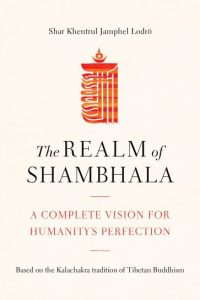Tuesday
UncategorizedTHE REALM OF SHAMBHALA by Shar Khentrul Jampel Lodrö
 Review and Brief Commentary by Christine Heming
Review and Brief Commentary by Christine Heming
Shambhala is . . . the ultimate manifestation of peace and harmony. It is the realization … of those two qualities and the revelation of their capacity. Like the sun hidden behind clouds, every so often we can get a glimpse of its dazzling rays.
Part 1: The ultimate meaning of Shambhala
The Realm of Shambhala is an excellent introduction to the view of Shambhala based on the Kalachakra tradition. There are details about Shambhala in this book that were unknown to me, and there are differences in the language and emphasis of the author, Khentrul Rinpoche. But the essence of what is presented in The Realm of Shambhala is remarkably familiar. Although the Vidyadhara, Trungpa Rinpoche, made it clear that he was not teaching the Kalachakra tantra, his knowledge of this tantra and its influence on what has been handed down to his students is quite apparent when one reads this account written by Khentrul Rinpoche, a Kalachakra lineage holder.
The Preface, written by the Venerable Tempa’i Gyaltsen, tells the story of the origin of this teaching: After a six-month teaching tour, Khentrul Rinpoche realized how little people understood about Shambhala, what it actually was. He set about writing this short accessible book “to clarify the confusion surrounding Shambhala and to provide the basis for connecting with its deeply profound nature.”
In the Introduction, Khentrul Rinpoche, touches on the problem of extreme views – scientific materialism and religious extremism – that dominate much of the thinking within our world. He presents the teachings of the Kalachakra as a balanced approach to life, a middle ground. He says the Kalachakra can be differentiated from other Buddhist tantras because of its expansive scope (“the theory of everything”), its clarity and its profound methods.
According to Trungpa Rinpoche, the Kalachakra tantra is within the anuttarayoga yana, like Chakrasamvara and Vajrayogini. All of these tantras exist for the same reason – to lead practitioners to complete enlightenment. But there seems to be something particularly potent about the Kalachakra, and it is the tantra with a direct connection to Shambhala. As the story goes, it was the first king of Shambhala, Suchandra (Dawa Sangpo in Tibetan), who invited the Buddha to give him teachings that would enable him to attain the supreme enlightenment while remaining the sovereign of Shambhala. The teaching the Buddha gave to Suchandra, as well as many other kings, was the Kalachakra.
Shambhala According to the Kalachakra
Khentrul Rinpoche distinguishes between Shambhala as a “realm” and Shambhala as a “state of mind”- a state of mind that can be cultivated through the practice of a spiritual path. He describes this mind of Shambhala as “the perfection of peace and harmony.” Peace refers to our own personal experience, and harmony is the natural expression of that peace through our connections with the environment and our relationships with others. It is a state of mind in which there is no conflict, no contradiction and no separation. Perfection means that it is the ultimate manifestation, the full realization of those qualities. He uses the metaphor of the sun hidden behind the clouds; we glimpse its dazzling radiance, and with the right methods, we can strengthen the conditions that reveal more and more of its essence.
Various ideas about Shambhala have existed both in the traditional cultures of central Asia and, more recently, in Western cultures. Khentrul Rinpoche recognizes our Shambhala lineage as an example of using the principles of peace and harmony to create an enlightened society, in particular through Shambhala Training. He describes the Vidyadhara Trungpa Rinpoche as a visionary who received teachings from the kings of Shambhala. He also notes that the Vidyadhara’s teachings on Shambhala incorporate ideas from the Kalachakra. But he stops short of seeing our path as a complete path to enlightenment. It appears his knowledge of our teachings and vision is limited to Shambhala Training.
The Provisional and Definitive Meaning of Shambhala
Khentrul Rinpoche reminds readers of the four reliances: (1) Rely on the teaching, not the teacher; (2) Rely on the meaning, not the words; (3) Rely on the definitive meaning, not the provisional meaning; (4) Rely on primordial wisdom, not consciousness. This is not to suggest that we rely on the first and reject the second. Rather, these four tell us where to put our emphasis, which one will enable us to go deeper.
It is within this teaching that Khentrul Rinpoche distinguishes the notions of provisional and definitive meaning. Provisional views or teachings refer to conceptual understanding; they are temporary views we hold in order to later understand or realize a more profound truth. Here is a familiar notion: “they are stepping stones that lead us closer to the definitive truth one layer of understanding at a time.” Provisional teachings “allow practitioners of different capacities to clear away layers of confusion.” Eventually all these layers are abandoned when the definitive wisdom, the true nature of reality, is realized. Not understanding the full nature of the transmissions received and taught by the Vidyadhara, he refers to his teachings on creating enlightened society as provisional.
The provisional teachings are necessary. What we learn through these teachings strengthens the right karmic propensities so that gradually the conditions for realizing the ultimate, definitive truth can occur. The Kalachakra path includes such provisional teachings as an ethical system of conduct providing the proper foundation for us to experience subtler and subtler layers of reality. This system has three levels: nonviolence, rime philosophy and pure perception. Nonviolence is the cultivation of loving-kindness and compassion. Rime means without bias, a mind free from self-centeredness. Pure perception is the result of the first two; gradually we are able to go deeper and experience the profound meaning of Shambhala.
Therefore Shambhala can manifest as both a provisional teachings rooted in loving-kindness and compassion, and as the ultimate or “sublime realm.” To realize the definitive meaning of Shambhala is to experience this ultimate state of mind, which is described as emptiness and great bliss. Empty is the complete absence of any conceptual projection onto reality. That emptiness, however, is not a mere void; it is full of enlightened qualities, the natural luminosity of reality. Bliss is the “incredible mind of nongrasping.” Once realized, this experience needs to be perfected until the subtlest traces of habitual propensities are cleared away.
Read part two here.
 Christine Heming is a writer and educator. She has been a student of the buddhadharma for over 45 years, and a senior teacher and meditation instructor in Shambhala. She lives in Port Royal, Nova Scotia.
Christine Heming is a writer and educator. She has been a student of the buddhadharma for over 45 years, and a senior teacher and meditation instructor in Shambhala. She lives in Port Royal, Nova Scotia.




